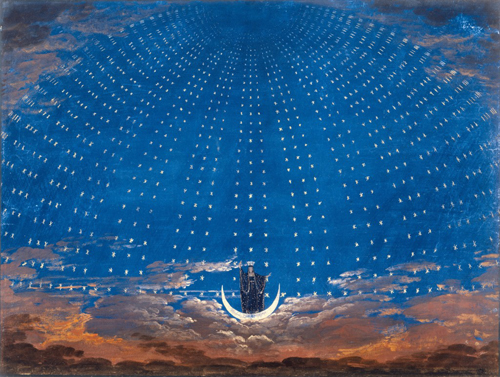Ten Thousand Hours
Jerry Orter
May 2016
 Queen of the Night by Karl Friedrich Schenkel
Queen of the Night by Karl Friedrich Schenkel
Is what you see really what you see?
Most people are visually illiterate. Why should it be otherwise? We have a text based culture. Our education systems teach us to value text over image, which is one of the reasons why we have such an impoverished cinema. Just because you have eyes does not mean to say that you can see. From childhood, when we are persuaded to pursue the alphabet, through adolescence when we are taught to amass vocabulary and refine our word skills, to adulthood when we never finish polishing our ability to communicate through words proportionately in our culture, very few people will spend as much time and patience and intelligence reading paintings as they do reading text. Our sophistications of communication are text based in the spoken and the written word, and by consequence, by comparison, the interpretation of the manufactured image in our culture is undernourished, ill- informed and impoverished.
Peter Greenaway
Rembrandt’s J’AccuseEach and every day when I visit Facebook, artist Gary Meyer posts 2 or 3 or 4 of his day’s drawings or paintings. Obsessed and prolific, he has well over 10,000 paintings and drawings in storage. He once confessed to me that he can’t not make art.
If you’re a joke maker it’s hard not to make jokes.
I can write jokes and it’s hard not to write them.Woody Allen
MASLOW’S HAMMER
If all you have is a hammer, everything looks like a nail.
Give a boy a hammer and chisel; show him how to use them;
at once he begins to hack the doorposts, to take off the
corners of shutters and window frames, until you teach him a
better use for them, and how to keep his activity within bounds.
Once A Week
London, 1860
Give a small boy a hammer, and he
will find that everything he encounters needs pounding.
Abraham Kaplan
The law of instrument
If a person is familiar with a single subject, or has with them a certain single instrument, they may have a confirmation bias to believe that it is the answer to/involved in everything.
TEN THOUSAND HOUR RULE
A group of really brilliant psychologists in the field of expertise research have sat down and tried to figure out “How long do you have to work at something before you become really good.” and, the answer seems to be, it’s an extraordinary consistent answer in an incredible number of fields, and, that is you need to have practiced, to have apprenticed for 10,000 hours before you get good. So, every great classical composer without exception composes for at least 10 years before they write their masterwork. Mozart is composing at eleven but he’s composing garbage at eleven. He doesn’t compose something great until he’s twenty two or twenty three; Concerto #9, I think, K271.
Malcolm Gladwell
.
Queen of the Night aria, Magic Flute, Mozart
Luciana Serra, soprano and anonymous 8 year old girl

Jerry, I can’t imagine how long it took you to do the editing on that video! Brilliant work on this piece! !!!
That is awesome. I tip my hat to the 8 year old, it’s evident how much she loves the music.
Jerry,
in the east, “Ten Thousand” signifies “infinite” … what a perfect title! I love it…
ps: a great meditation!
Yuko,
thank you so much. 10,000 hours in the arts represents commitment and maturity and expertise. In the East (where wisdom comes from) the focus is on perfection. In the West the focus is on innovation. Elements for a happy marriage.
Love the 8 year old girl–she has passion!
Jerry Orter’s Art/Philosophy multi-media piece, TEN THOUSANDHOURS invites serious thought for at least 2 reasons: What’s there, and what isn’t, or what is there again but perhaps insufficiently.
The parts which constitute the statement are many;
each and all compelling, evocative and stimulating.
Yet, I’m lead to wonder if there isn’t something
under revealed here in the way of synthesis.
I believe there is a hidden; esoteric, if you will, job
for the artist who would be great while said artist
is putting in the TEN THOUSAND HOURS of practice; The second job is, in fact creating the
artist who is up to the task of creating the great
ART.
While Andy was practicing commercial illustration,
he was thinking and creating ANDY WARHOL, of course. He had yet to put his WARHOL on, one might say.
This is what left WITTGENSTEIN feeling a little
pissed-off at WILLIAM SHAKESPEARE, he too
created , certainly, a great artist’s identity but buried it so deeply into his works no one knows
who it was. He kept it to himself. There was no
personal revelation.
Whereas, getting back to Warhol, Andy didn’t
paint soup cans because, as he claimed, he was so
sentimental about tomato soup,( ha ha ha.) But rather to dramatize emptiness as JEAN BAUDRILLARD, insightfully put it. Emptiness cold
as death. And if the soupless can didn’t drive the
point all the way home, it was followed up by THE
ELECTRIC CHAIR, no mistaking that dark empty
solitary piece of furniture for bringing anything other than the big emptiness of the most permanent kind.
This artist well exemplifies the TEN THOUSAND
HOURS of craft practice to begin greatness as well as the other side the herculean inside artist’s identity myth creation, that makes the greatness of art possible.
Even the astonishingly talented operatic 8 years
old little woman will eventually have to decide
where she will take her great voice and skills, &
to what purpose.
Very well done JERRY.
PETER KERNZ
(Painter)